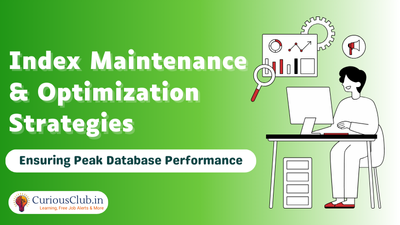
Master Index Maintenance & Optimization Strategies for SQL databases. Learn best practices for maintaining efficient indexes and improving query performance. Understand how to identify and resolve index fragmentation, choose the right indexing strategies, and monitor index usage for optimal database health. Read More
Introduction
Indexes are essential for improving SQL query performance, but they require regular maintenance to stay efficient. Over time, indexes can become fragmented, outdated, or even unnecessary, leading to performance degradation. In this article, we’ll cover:
- Why index maintenance is crucial
- How to detect and fix index fragmentation
- When to rebuild or reorganize indexes
- Strategies for keeping your indexes optimized
By the end of this guide, you’ll know how to ensure your indexes continue to boost performance rather than hinder it.
Why Index Maintenance Matters
Indexes are like a library’s catalog system: they help locate books (data) faster. However, without regular upkeep, the catalog can become messy and inefficient, leading to:
🔹 Slower queries due to fragmented indexes.
🔹 Increased storage usage from redundant or unused indexes.
🔹 Higher maintenance costs in terms of CPU and disk I/O.
Common Index Problems
- Fragmentation – Over time, data modifications cause index pages to become disorganized, slowing down queries.
- Unused Indexes – Some indexes may not be used frequently and only add overhead.
- Over-Indexing – Too many indexes slow down
INSERT,UPDATE, andDELETEoperations.
Detecting and Fixing Index Fragmentation
Checking Index Fragmentation
Use the following SQL query to check fragmentation in SQL Server:
SELECT dbschemas.[name] AS SchemaName,
dbtables.[name] AS TableName,
dbindexes.[name] AS IndexName,
indexstats.avg_fragmentation_in_percent
FROM sys.dm_db_index_physical_stats(DB_ID(), NULL, NULL, NULL, 'LIMITED') AS indexstats
JOIN sys.tables AS dbtables ON dbtables.[object_id] = indexstats.[object_id]
JOIN sys.schemas AS dbschemas ON dbtables.[schema_id] = dbschemas.[schema_id]
JOIN sys.indexes AS dbindexes ON dbindexes.[object_id] = indexstats.[object_id]
AND indexstats.index_id = dbindexes.index_id
ORDER BY indexstats.avg_fragmentation_in_percent DESC;A fragmentation level:
✅ Below 5%: No action needed.
⚠️ 5%-30%: Consider reorganizing.
🚨 Above 30%: Consider rebuilding the index.
Rebuilding vs. Reorganizing Indexes
- Rebuild Index (
ALTER INDEX ... REBUILD) – Drops and recreates the index, fully defragmenting it. - Reorganize Index (
ALTER INDEX ... REORGANIZE) – Defragments pages without dropping the index.
Example:
ALTER INDEX idx_customer_id ON Orders REBUILD;
-- OR
ALTER INDEX idx_customer_id ON Orders REORGANIZE;Index Cleanup: Dropping Unused Indexes
Unused indexes take up space and slow down write operations. To identify and remove them:
Finding Unused Indexes
SELECT i.name AS IndexName, t.name AS TableName,
user_seeks, user_scans, user_lookups, user_updates
FROM sys.dm_db_index_usage_stats us
JOIN sys.indexes i ON i.object_id = us.object_id AND i.index_id = us.index_id
JOIN sys.tables t ON t.object_id = i.object_id
WHERE user_seeks + user_scans + user_lookups = 0;Dropping an Index
DROP INDEX idx_unused ON Customers;Best Practices for Index Optimization
✅ Regularly monitor index usage with performance monitoring tools.
✅ Avoid redundant indexes by indexing only necessary columns.
✅ Balance read and write performance – More indexes improve reads but slow down writes.
✅ Use index compression where supported to reduce storage impact.
✅ Schedule index maintenance during off-peak hours to minimize disruption.
Conclusion
Proper index maintenance is crucial for ensuring your SQL database performs efficiently. By monitoring fragmentation, reorganizing or rebuilding indexes, and removing unused ones, you can keep your queries running fast while minimizing storage overhead.
📌 Coming Next: Query Execution Plans & Advanced Optimization Techniques
Stay tuned for deeper insights into SQL performance tuning! 🚀
Join Telegram | Join WhatsApp Channel
We hope this article was helpful for you and you learned a lot of new things from it. If you have friends or family members who would find it helpful, please share it to them or on social media.
Also Read:
- Mastering Pivot Table in Python: A Comprehensive Guide
- Data Science Interview Questions Section 3: SQL, Data Warehousing, and General Analytics Concepts
- Data Science Interview Questions Section 2: 25 Questions Designed To Deepen Your Understanding
- Data Science Questions Section 1: Data Visualization & BI Tools (Power BI, Tableau, etc.)
- Optum Interview Questions: 30 Multiple Choice Questions (MCQs) with Answers
Hi, I am Vishal Jaiswal, I have about a decade of experience of working in MNCs like Genpact, Savista, Ingenious. Currently i am working in EXL as a senior quality analyst. Using my writing skills i want to share the experience i have gained and help as many as i can.
